Snowshoeing in Washington offers a low-impact way to immerse yourself in winter adventure. Abundant winter trail systems boast panoramic viewpoints, peaceful ridgelines, and classic Pacific Northwest mountain scenery.
Whether you’re an experienced snowshoer or just starting out, there’s a trail for every skill level. Many recommended snowshoe routes can be found near ski resorts or winter recreation hubs like Snoqualmie Pass, making them easy add-ons to a mountain getaway or itinerary.
This snowshoeing travel guide highlights scenic winter routes throughout Washington’s mountain regions and provides logistics, suggestions on where to stay, and more. You’ll also find ideas for multi-day road trip itineraries for winter trip planning. And don’t worry if you don’t have your own gear. Many outdoor shops, mountain lodges, and ski areas offer snowshoe rentals.
At a Glance: Snowshoe Trail Guide
- Wenatchee Crest Trail, Blewett Pass: best for beginners, families, access to a winter recreation area
- Sun Mountain Loop, Methow Valley: best for lodge-based winter getaway near a Nordic ski network
- Hurricane Ridge, Olympic National Park: best for panoramic mountain and coastal views
- Cooper River, Salmon la Sac: best for riverside scenery, wildlife sightings, and peaceful forest terrain
- Skyline Lake, Stevens Pass: best for short but steep climbs and alpine lake views near a ski area
- Artist Point, Mount Baker: best for high-alpine terrain and experienced snowshoers near a ski area
- June Lake, Mount St. Helens: best for winter waterfall views, volcano scenery, sno-park trail network
- Mazama Ridge, Mount Rainier: best for mountain scenery, snow-covered meadows, winter recreation hub
- Mount Spokane Summit, Spokane area: best for challenging ascents and panoramas near a ski resort

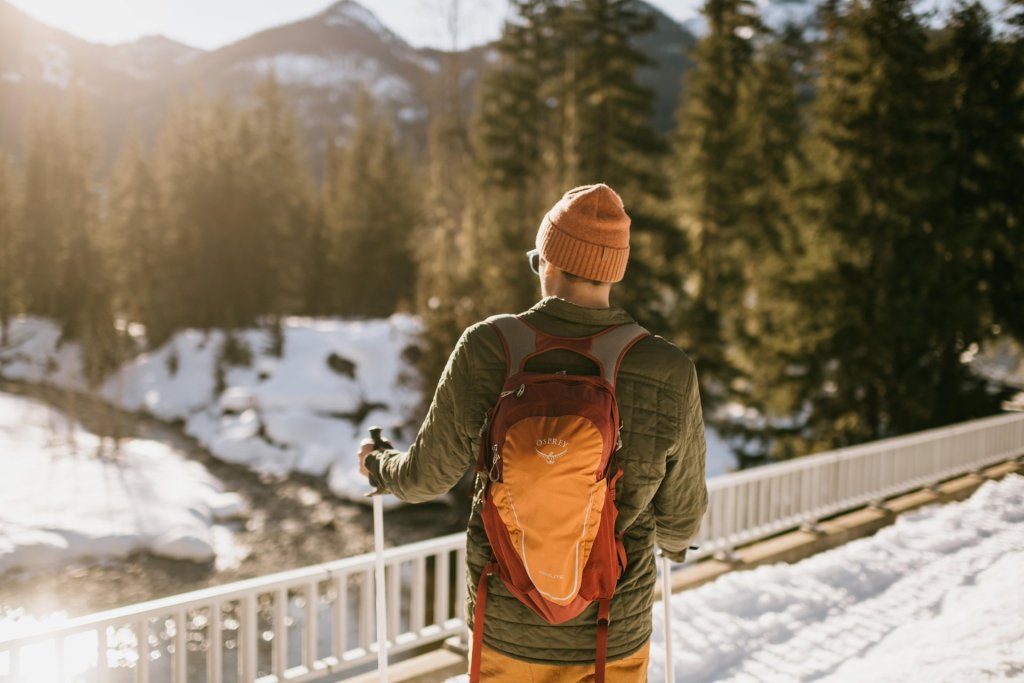
Snowshoe Trail Guide: Where to go Snowshoeing in Washington
Each trail listing includes route details and where to stay nearby so you can plan day trips, overnight stays, or a multi-stop winter road trip.
Winter Safety Tip: While the following routes are generally considered lower risk for avalanches, mountain conditions can change quickly. Always check the Northwest Avalanche Center forecast and familiarize yourself with snow safety.
Wenatchee Crest Trail, Blewett Pass
Trail details: 6 miles | 400 feet elevation gain
Parking: Blewett Pass Sno-Park, Sno-Parks permit required
Difficulty level: Easy-Moderate
Located along Highway 97 between Leavenworth and Cle Elum, this route is a convenient stop on winter road trips through the Central Cascades. Starting high up on Blewett Pass, this ridgetop out-and-back snowshoe trail doesn’t have much elevation gain but affords expansive views of Glacier Peak, Mount Rainier, and the Teanaway Mountains. Later in the season, this route sees more crowds on weekends as the snow at lower elevations melts.
Where to stay: Roslyn or Leavenworth are both great base camps for visiting this mountain pass.
Hurricane Ridge, Olympic National Park

Trail details: 6 miles | 800 feet elevation gain
Parking: Hurricane Ridge, National Park Pass required
Difficulty level: Moderate
Hurricane Ridge is considered by many to be one of the top scenic snowshoe trails in Washington. This exposed ridgeline trail offers 360-degree views of Mount Baker, the Olympic Range, Puget Sound, and the Strait of Juan de Fuca. In winter, Hurricane Ridge Road is only open to traffic Friday-Sunday and some holidays, so time your trip accordingly.
Travel Tip: All vehicles are required to carry tire chains when traveling above the Heart O’ the Hills entrance from November through April 1. If visiting on the weekend, consider taking the shuttle from Port Angeles.
Where to stay: Winter is the perfect time to explore the nearby Port Angeles or Port Townsend.
Also See: Discover Olympic National Park
Skyline Lake, Stevens Pass
Trail details: 3 miles | 1,100 feet elevation gain
Parking: Stevens Pass northern parking lot, free
Difficulty level: Moderate
This short, rigorous climb lands snowshoers at an incredible frozen lake basin with views of Big Chief and Cowboy Mountains, as well as the Alpine Lakes Wilderness. Continue around the lake to the gap on the ridge’s northwest side (do not cross the lake) for even more dazzling views. The vista opens and showcases the Enchantments, Glacier Peak, Nason Ridge, and many more. This extra jaunt adds a little more climbing, but it’s worth it.
Easily accessible from the Stevens Pass ski area, this route is a favorite winter outing for visitors looking to pair a short snowshoe adventure with a day hitting the slopes at one of Washington’s ski resorts.
Where to stay: For a scenic mountain getaway, base yourself in Leavenworth in the foothills of the Cascade Mountains.
Sun Mountain Snowshoe Loop, Methow Valley
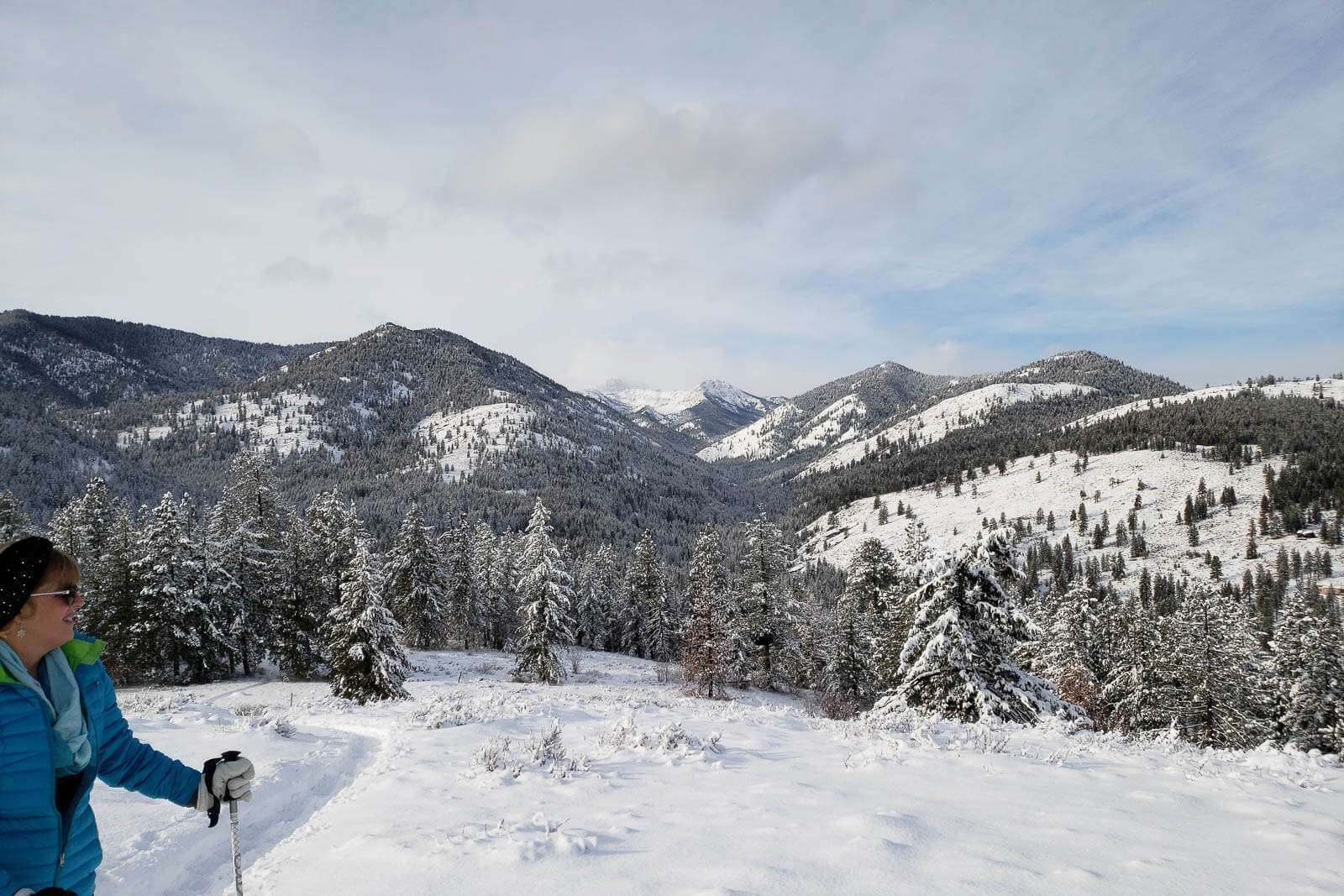
Trail details: 2.8 miles | 690 feet elevation gain
Parking: Sun Mountain parking lot, Methow Valley snowshoe pass
Difficulty level: Moderate
Winter outdoor enthusiasts flock to the Methow Valley for its trail infrastructure and outstanding beauty. Located at Sun Mountain Lodge, this snowshoe loop is an easy resort-accessible route offering valley views. In fact, Snowshoe Magazine named it a top snowshoe destination for couples. The loop connects the Moose, Black Bear, and Clic-A-Pic trails. Travel tip: Trail markers may be hard to spot after fresh snowfall.
The Methow Valley is also home to North America’s largest cross-country ski area, making it a top destination for cross-country skiing in Washington.
Where to stay: Bed down at Sun Mountain Lodge and enjoy amenities like a hot tub and cozy rooms.
Artist Point, Mount Baker
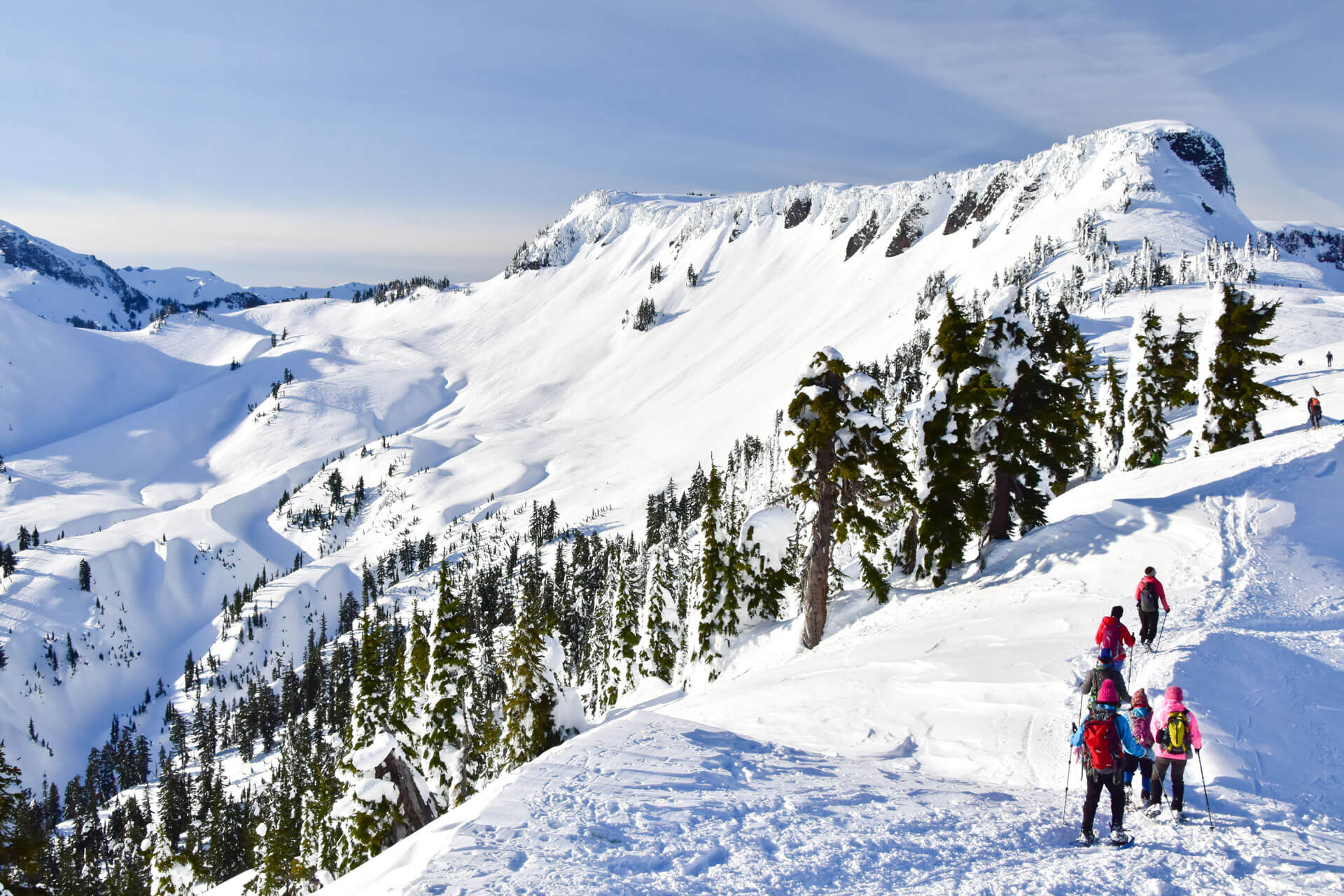
Trail details: 4 miles | 1,000 feet elevation gain
Parking: Heather Meadows/Mount Baker Ski Area overflow, free
Difficulty level: Moderate
Artist Point delivers some of the most scenic alpine terrain in Washington. Starting near the Mount Baker Ski Area, snowshoers climb into dramatic high-country bowls framed by Mount Shuksan and Mount Baker. While not an overly lengthy route, this a good it for experienced snowshoers due to some steep sections. The final section of Mount Baker Highway closes each winter, so start the trail near the restrooms at the Heather Meadows parking lot at the Mount Baker Ski Area.
Travel Tip: Consult the Northwest Avalanche Center forecast before visiting, as a portion of this route route goes through avalanche terrain. If it’s snowing or fogged in, make sure someone in your group has route-finding skills.
Nearby, White Salmon Road is great for beginners. With only 450 feet of elevation gain, you can start at the Salmon Ridge Sno-Park and walk along the Nooksack River Valley.
Where to stay: Base yourself in the outdoorsy town of Bellingham, about a 1.5 hours to the west.
Cooper River, Salmon le Sac
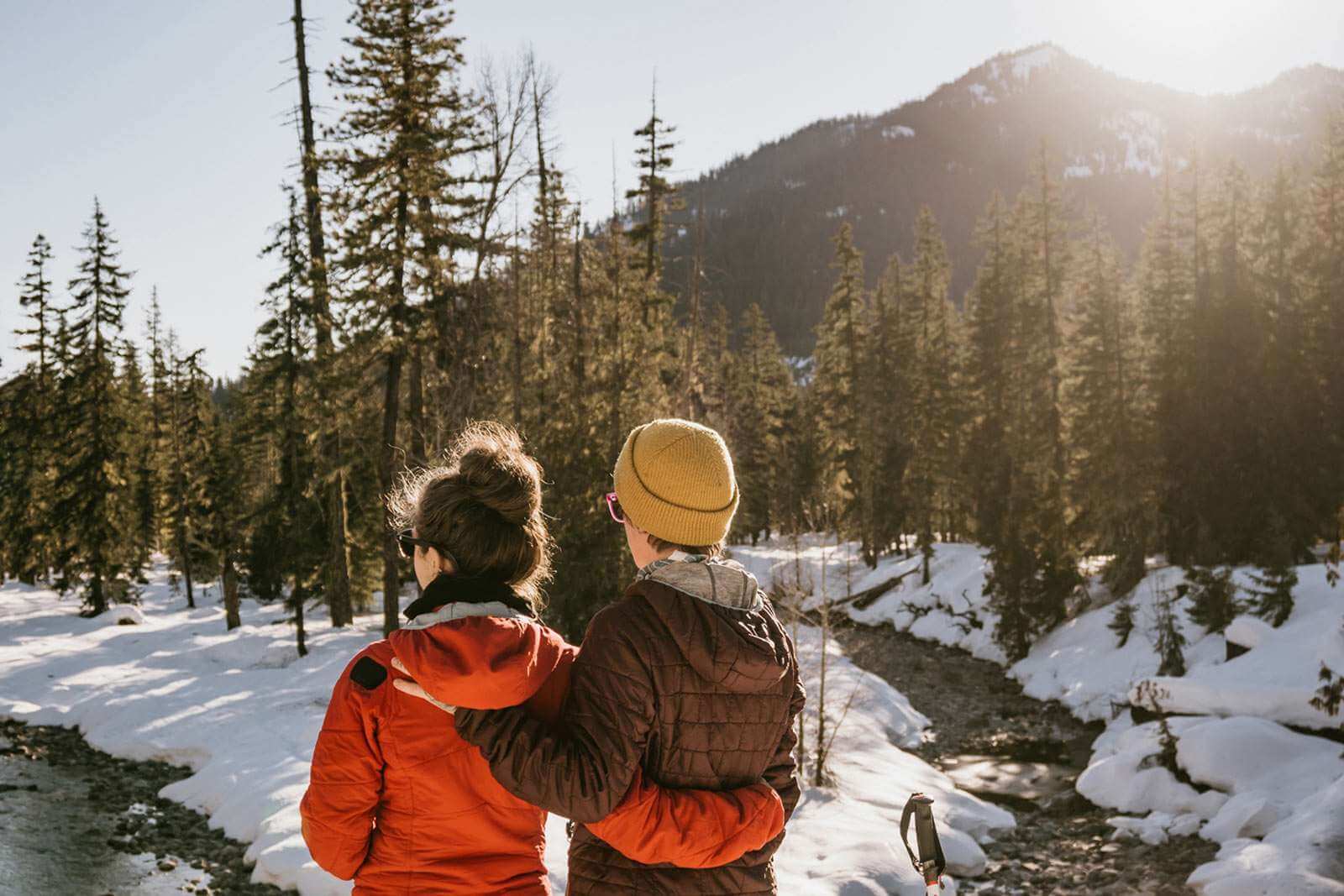
Trail details: 8 miles | 400 feet elevation gain
Parking: Salmon de Sac Sno-Park, Sno-Parks permit required
Difficulty level: Moderate
This out-and-back trek tours a river valley and old-growth forests of cedar, white pine, Douglas fir, and vine maple. The gently rolling trail is quiet outside of peak weekend times and allows snowshoers to observe many bird species and other wildlife, as well as enjoy the sound of the river. Turn around at Cooper Lake, which is also a great spot for lunch. Note that the trailhead is about a mile from the sno-park parking lot.
Where to stay: Bed down at nearby Suncadia Resort or in the charming town of Roslyn.
Also See: Winter Getaway in the Cascade Mountains
June Lake, Mount St. Helens
Trail details: 4.8 miles | 500 feet elevation gain
Parking: Marble Mountain Sno-Park, Sno-Parks permit required
Difficulty level: Moderate
Options abound for snowshoers at the Marble Mountain Sno-Park in Gifford Pinchot National Forest, which boasts 50 miles of trails. Of the choices, June Lake is an especially scenic snowshoe trail for a winter ramble. You’ll follow a trail on a forested creek with excellent Mount St. Helens views. At June Lake, a 40-foot icicled waterfall cascades near the shore. To avoid snowmobilers, opt for the trail instead of the road. Note this area can be busy on winter weekends.
Where to stay: Pair your snowshoe adventure with a stay along the Columbia River in Vancouver, WA.
Mazama Ridge, Mount Rainier
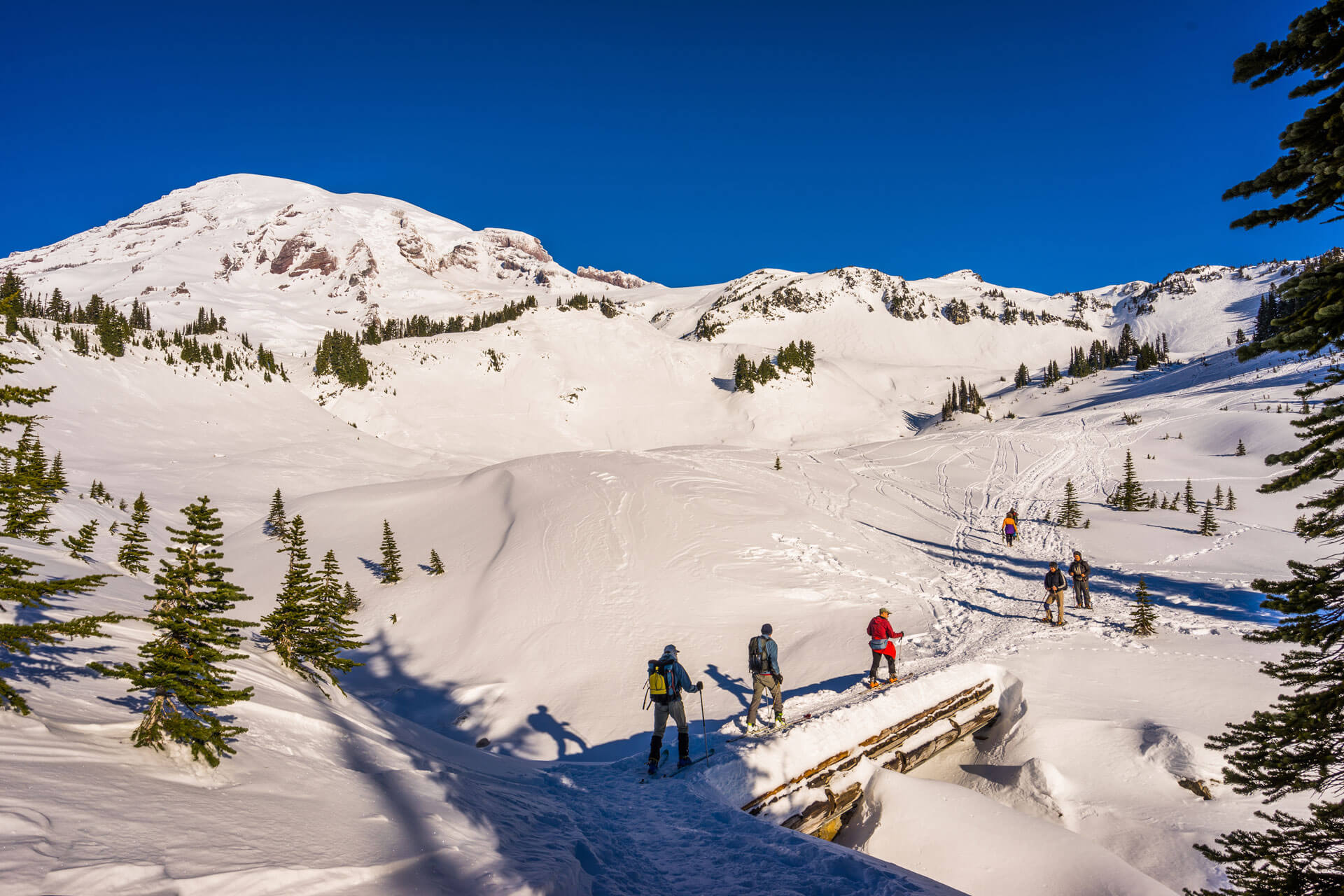
Trail details: 6 miles | 900 feet elevation gain
Parking: Paradise lot, National Park Pass required
Difficulty level: Moderate
This intermediate-level snowshoe trail takes you through snow-covered alpine meadows with panoramic views of Mount Rainier and the Tatoosh Range. To avoid avalanche danger, park rangers recommend taking the Paradise Valley Road to the 4th Crossing route. Head over the Edith Creek footbridge above scenic Myrtle Falls before continuing east across the upper area of Paradise Valley towards Mazama Ridge and stellar views.
Travel Tip: If driving, the park requires vehicles to carry chains from Nov. 1 through March 1.
Where to stay: Just a short drive from the Paradise area of Mount Rainier, the National Park Inn is a great option for those looking for a rustic mountain escape.
Mount Spokane Summit Route, Spokane area
Trail details: 4 miles | 1,330 feet elevation gain
Parking: Mount Spokane State Park, Sno-Parks permit required
Difficulty level: Difficult
This short out-and-back climb heads straight to the Mount Spokane summit, giving snowshoers the satisfaction of bagging a peak in the Selkirk Mountain Range about an hour northeast of Spokane. Those visiting on a weekend can reward themselves with a cup of hot cocoa from the concession stand at the top. If peak bagging is not your thing, there are many other trail options, including Mount Kit Carson Loop Road.
Where to stay: Check into one of the many Davenport Hotels in Spokane.
Also See: Where to go Snowmobiling
Washington Snowshoe Itinerary Ideas
Use the sample itinerary ideas below to organize a multi-day winter trip.
Winter Road Trip Itinerary 1: Seattle Loop
This multi-day snowshoe road trip route is one of the shortest loops possible from Seattle, and you’ll hit three major winter corridors along the way.
Day 1: Snoqualmie Pass Corridor
- Snowshoe trail: Cooper River
- Home base: Roslyn / Cle Elum area
- Driving times: Seattle to Snoqualmie Corridor (1–1.25 hours), drive to Roslyn/Cle Elum (35–45 minutes)
Day 2: Blewett Pass
- Snowshoe trail: Wenatchee Crest Trail
- Home base: Leavenworth
- Driving times: Roslyn/Cle Elum to Blewett Pass (1–1.25 hours), drive to Leavenworth (45–60 minutes)
Day 3: Stevens Pass
- Snowshoe trail: Skyline Lake
- Home base: return to Seattle or overnight in Everett
- Driving times: Leavenworth to Stevens Pass (45–55 minutes), drive to Seattle (1.75–2 hours)
Winter Road Trip Itinerary 2: Seattle to Spokane
A longer cross-state route where you can fly out of Spokane International Airport.
Day 1: Snoqualmie Pass Corridor
- Snowshoe trail: Cooper River
- Home base: Roslyn / Cle Elum
- Driving time: Seattle to Snoqualmie Corridor (1–1.25 hours), drive to Roslyn/Cle Elum (35–45 minutes)
Day 2: Methow Valley
- Snowshoe trail: Sun Mountain Snowshoe Loop
- Home base: Winthrop / Sun Mountain Lodge
- Driving time: Roslyn/Cle Elum → Methow Valley (about 3 hours)
Days 3-4: Mount Spokane
- Snowshoe trail: Mount Spokane Summit Route
- Home base: Spokane (can fly out of GEG, Washington’s second-largest airport)
- Driving time: Methow Valley to Mount Spokane (4-5 hours)
- Travel tip: Due to a longer drive time, plan to spend two nights in Spokane
Travel Tips & Winter Safety
- Check the Northwest Avalanche Center website for avalanche forecasts.
- Check trail conditions by viewing recent trip reports or calling the ranger district.
- Make sure you have the route-finding and avalanche safety skills for your chosen trek.
- Check road conditions on the Washington Department of Transportation’s website.
- Bring the 10 essentials, as well as a warm, waterproof layers and footwear.
Snowshoeing in Washington FAQ
When is the best time to plan a snowshoe trip in Washington?
Snowshoeing season typically runs from December through March. High-elevation areas near ski resorts and mountain passes, such as Snoqualmie Pass, can often have snow earlier or later in the season.
What passes or permits do I need for snowshoe trails?
Many winter trailheads require a sno-park permit, while those in Mount Rainier and Olympic National Park require a National Park Pass. Some ski areas offer free overflow parking for winter trail users.
Where can I rent snowshoes?
Snowshoe rentals are available at ski resorts, outdoor retailers, and many community gear shops in towns such as Leavenworth, Winthrop, and Bellingham.
About the Author
Ellee Thalheimer is a freelance writer and guidebook author based in the Pacific Northwest who has contributed to publications like Lonely Planet Guidebooks, Alaska Airlines Magazine, and Adventure Cyclist Magazine.
